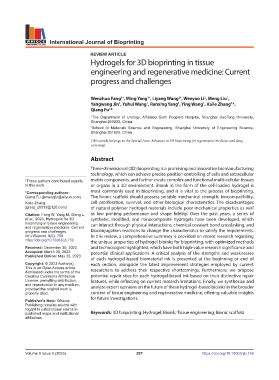Page 215 - IJB-9-5
P. 215
International Journal of Bioprinting
REVIEW ARTICLE
Hydrogels for 3D bioprinting in tissue
engineering and regenerative medicine: Current
progress and challenges
Wenzhuo Fang , Ming Yang , Liyang Wang , Wenyao Li , Meng Liu ,
1†
2†
2
1
1†
Yangwang Jin , Yuhui Wang , Ranxing Yang , Ying Wang , Kaile Zhang *,
1
1
1
1
1
Qiang Fu *
1
1 The Department of Urology, Affiliated Sixth People’s Hospital, Shanghai JiaoTong University,
Shanghai 200233, China
2 School of Materials Science and Engineering, Shanghai University of Engineering Science,
Shanghai 201620, China
(This article belongs to the Special Issue: Advances in 3D bioprinting for regenerative medicine and drug
screening)
Abstract
Three-dimensional (3D) bioprinting is a promising and innovative biomanufacturing
technology, which can achieve precise position controlling of cells and extracellular
† These authors contributed equally matrix components, and further create complex and functional multi-cellular tissues
to this work. or organs in a 3D environment. Bioink in the form of the cell-loaded hydrogel is
*Corresponding authors: most commonly used in bioprinting, and it is vital to the process of bioprinting.
Qiang Fu (jamesqfu@aliyun.com) The bionic scaffold should possess suitable mechanical strength, biocompatibility,
Kaile Zhang cell proliferation, survival, and other biological characteristics. The disadvantages
(great_z0313@126.com) of natural polymer hydrogel materials include poor mechanical properties as well
Citation: Fang W, Yang M, Wang L, as low printing performance and shape fidelity. Over the past years, a series of
et al., 2023, Hydrogels for 3D synthetic, modified, and nanocomposite hydrogels have been developed, which
bioprinting in tissue engineering can interact through physical interactions, chemical covalent bond crosslinking, and
and regenerative medicine: Current
progress and challenges. bioconjugation reactions to change the characteristics to satisfy the requirements.
Int J Bioprint, 9(5): 759. In this review, a comprehensive summary is provided on recent research regarding
https://doi.org/10.18063/ijb.759 the unique properties of hydrogel bioinks for bioprinting, with optimized methods
Received: December 30, 2022 and technologies highlighted, which have both high-value research significance and
Accepted: March 30, 2023 potential clinical applications. A critical analysis of the strengths and weaknesses
Published Online: May 23, 2023
of each hydrogel-based biomaterial ink is presented at the beginning or end of
Copyright: © 2023 Author(s). each section, alongside the latest improvement strategies employed by current
This is an Open Access article researchers to address their respective shortcomings. Furthermore, we propose
distributed under the terms of the
Creative Commons Attribution potential repair sites for each hydrogel-based ink based on their distinctive repair
License, permitting distribution, features, while reflecting on current research limitations. Finally, we synthesize and
and reproduction in any medium, analyze expert opinions on the future of these hydrogel-based bioinks in the broader
provided the original work is
properly cited. context of tissue engineering and regenerative medicine, offering valuable insights
for future investigations.
Publisher’s Note: Whioce
Publishing remains neutral with
regard to jurisdictional claims in
published maps and institutional Keywords: 3D bioprinting; Hydrogel; Bioink; Tissue engineering; Bionic scaffold
affiliations.
Volume 9 Issue 5 (2023) 207 https://doi.org/10.18063/ijb.759

